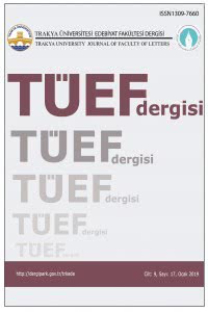Byronik Kahraman Mitinin E. L. James’in Grinin Elli Tonu Eserinde Yeniden Yorumlanması
Byronik kahramanının tam anlamıyla bir edebî mit olarak kabul edilebileceğini ve çağdaş popüler kültürümüzün, çeşitli antik ve modern mitlere sürekli ilgi gösterip, bu ilgiyi sadece ürünlerinde sınırlı tutmayıp, edebiyatlarında da bu mitlerin tematik perspektiflerini, sürekli olarak yeniden yazdığını ve yeniden şekillendirdiğini varsayarak, bu çalışma E. L. James’in popüler hale gelmiş Grinin Elli Tonu roman üçlemesine odaklanır ve bu varsayımları tartışmayı ve örneklendirmeyi amaçlar. Bu çalışma, Byron kahramanını on dokuzuncu yüzyıl edebiyatında tasvir edildiği gibi ele alır ve bu edebi temsilin, çağdaş sanatçıları ve okuyucuları nasıl büyülemeye devam ettiğini ve çağdaş romansta beklenmedik bir formda nasıl şekillendiğini ortaya çıkarmaya çalışır. Post-modern romans, üst ve alt kültürleri birleştirir ve bu çalışmada, yazarın akılcı bir yöntemle, mitolojik ve edebi mirasların zenginliğini, günümüz toplumunun çocuk istismarı, travma ve şiddet gibi bazı endişelerini iletmek için, romans tarzının sağladığı bazı çarpıcı imgelerle birleştirdiğini görmekteyiz. E.L. James’in serisinde yansıtıldığı haliyle, Byron kahramanı miti değişime uğramakta, ve toplumun normlarına uyabilen, travmasını atlatabilen ve gerçek aşkın keşfiyle iyileşen yeni bir Byron kahramanı versiyonu ortaya çıkmaktadır.
Anahtar Kelimeler:
Romans, edebî mit, Byron Kahramanı, travma, Grinin Elli Tonu
The Byronic Hero Myth Reloaded in E. L. James’s Fifty Shades of Grey Series
Assuming that the Byronic hero can be properly considered to be a literary myth and our contemporary popular culture keeps a constant interest in various ancient and modern myths by continuously rewriting and reshaping their thematic perspectives in its literary and not only products, the present study argues about and exemplifies these assumptions by focusing on E.L. James’s famous novel trilogy Fifty Shades of Grey. This study draws on the Byronic hero as depicted in the nineteenth-century literature and attempts to reveal how this literary representation continues to fascinate the contemporary artists and readers and is reshaped unexpectedly in the contemporary romance. The postmodern romance fuses high and low culture and this study presents the ways in which the novelist wittily combines mythical and literary heritages with the striking images allowed by the romance mode in order to convey some stringent concerns of the present day society, such as childhood abuse, trauma and violence. The myth of the Byronic hero, as expressed in E.L. James’s series, reveals a transformed version, a neo-Byronic protagonist who becomes adaptable to the norms of his community, is capable of moving beyond his trauma and is healed as a result of discovering his genuine love.
Keywords:
Romance, literary myth, the Byronic hero, trauma, Fifty Shades of Grey,
___
- Allan, Jonathan A. 2016. “The Purity of his Maleness”. In Journal of Men’s Studies, Vol. 24 (I): 24-41. SAGE Publications.
- Backès,Jean-Louis. 2010. Le Mythedans les littératuresd'EuropeParis: Cerf éditions, coll. «Cerf Littérature».
- Bloom, Sandra L. 2010. “Bridging the Black Hole of Trauma”. In Psychother. Politics. Int. 8(3): 198–212. Wiley Online Library.
- Brunel, Pierre, ed. 1992. Companion to Literary Myths, Heroes and Archetypes. Routledge: London.
- Concha, Ángeles de la. 2012. “Strangers to Ourselves: Story-telling and the Quest for the Self”. In Trauma and Romance in Contemporary British Literature. Edited by Onega Susana, and Ganteau Jean-Michel, Taylor&Francis Group.127-143.
- ISSN: 1309-7660
- Yayın Aralığı: Yılda 2 Sayı
- Başlangıç: 2011
- Yayıncı: -
Sayıdaki Diğer Makaleler
Andriake Limanı'ndan Koç Başı Saplı Bir Patera/Tagenon
Namık Kemal ve Ahmed Midhat Efendi’de Kadın Köleliğine Bakış
Prof. Dr. Vahit Türk Armağanı (2020), İstanbul: Kesit Yayınları, 1188 sayfa, ISBN: 978-625-7698-14-6
Kate Chopin’in The Awakening Adlı Romanının Türkçeye Çevirisinde Hitap Biçimleri
Orhon Yazıtlarında Özgürlük ve Başkaldırı Kavramları
